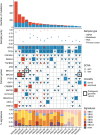ACT-Discover: identifying karyotype heterogeneity in pancreatic cancer evolution using ctDNA
- PMID: 37081523
- PMCID: PMC10120117
- DOI: 10.1186/s13073-023-01171-w
ACT-Discover: identifying karyotype heterogeneity in pancreatic cancer evolution using ctDNA
Abstract
Background: Liquid biopsies and the dynamic tracking of somatic mutations within circulating tumour DNA (ctDNA) can provide insight into the dynamics of cancer evolution and the intra-tumour heterogeneity that fuels treatment resistance. However, identifying and tracking dynamic changes in somatic copy number alterations (SCNAs), which have been associated with poor outcome and metastasis, using ctDNA is challenging. Pancreatic adenocarcinoma is a disease which has been considered to harbour early punctuated events in its evolution, leading to an early fitness peak, with minimal further subclonal evolution.
Methods: To interrogate the role of SCNAs in pancreatic adenocarcinoma cancer evolution, we applied whole-exome sequencing of 55 longitudinal cell-free DNA (cfDNA) samples taken from 24 patients (including 8 from whom a patient-derived xenograft (PDX) was derived) with metastatic disease prospectively recruited into a clinical trial. We developed a method, Aneuploidy in Circulating Tumour DNA (ACT-Discover), that leverages haplotype phasing of paired tumour biopsies or PDXs to identify SCNAs in cfDNA with greater sensitivity.
Results: SCNAs were observed within 28 of 47 evaluable cfDNA samples. Of these events, 30% could only be identified by harnessing the haplotype-aware approach leveraged in ACT-Discover. The exceptional purity of PDX tumours enabled near-complete phasing of genomic regions in allelic imbalance, highlighting an important auxiliary function of PDXs. Finally, although the classical model of pancreatic cancer evolution emphasises the importance of early, homogenous somatic events as a key requirement for cancer development, ACT-Discover identified substantial heterogeneity of SCNAs, including parallel focal and arm-level events, affecting different parental alleles within individual tumours. Indeed, ongoing acquisition of SCNAs was identified within tumours throughout the disease course, including within an untreated metastatic tumour.
Conclusions: This work demonstrates the power of haplotype phasing to study genomic variation in cfDNA samples and reveals undiscovered intra-tumour heterogeneity with important scientific and clinical implications. Implementation of ACT-Discover could lead to important insights from existing cohorts or underpin future prospective studies seeking to characterise the landscape of tumour evolution through liquid biopsy.
Trial registration: ClinicalTrials.gov NCT02795650.
Keywords: Cell-free DNA; Circulating tumour DNA; Copy number; Intra-tumour heterogeneity; Pancreatic cancer; Tumour evolution; cfDNA; ctDNA.
© 2023. The Author(s).
Conflict of interest statement
The affiliations of F.S. and C.A. with Peaches Biotech represent no conflict of interest with the study. M.H. is a member of the board of directors for Bristol Myers Squibb; is a founder of Champions Oncology, Inc., and Nelum Inc.; holds stock options for Champions Oncology, Inc.; InxMed; Biooncotech; and Bristol Myers Squibb; has received research support from Agenus; has received honoraria from InxMed, Oncomatrix, MiNKi, and Peaches Biotech; and has received royalties from Myriad and Khar. None of these represents a direct conflict of interest. N.M. has stock options in and has consulted for Achilles Therapeutics. N.M holds European patents relating to targeting neoantigens (PCT/EP2016/ 059401), identifying patient response to immune checkpoint blockade (PCT/EP2016/071471), determining HLA LOH (PCT/GB2018/052004), and predicting survival rates of patients with cancer (PCT/GB2020/050221). The remaining authors declare that they have no competing interests.
Figures




References
-
- Surveillance, Epidemiology and End Results Program (SEER). Encyclopedia of Global Health. 2008. Available from: 10.4135/9781412963855.n1142.
Publication types
MeSH terms
Substances
Associated data
Grants and funding
LinkOut - more resources
Full Text Sources
Medical

